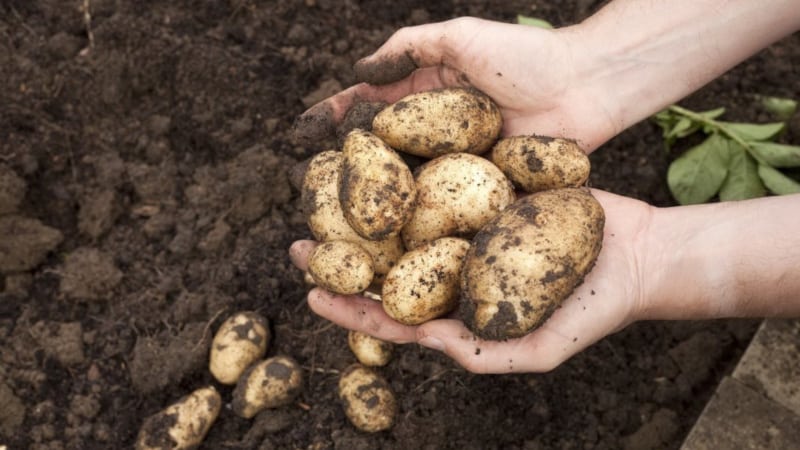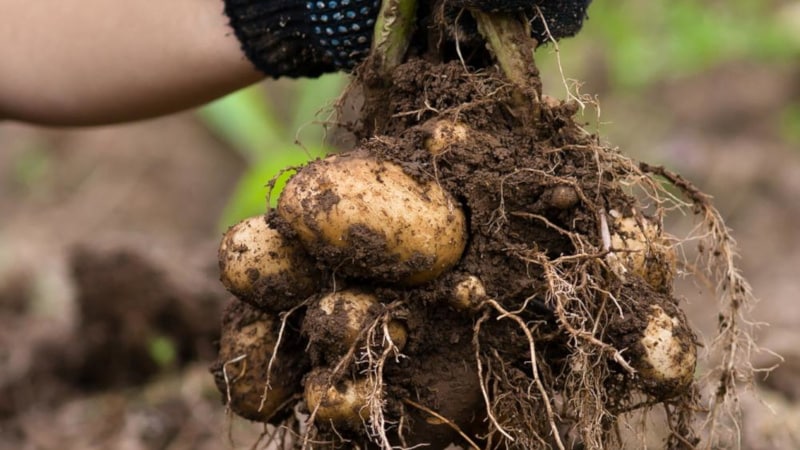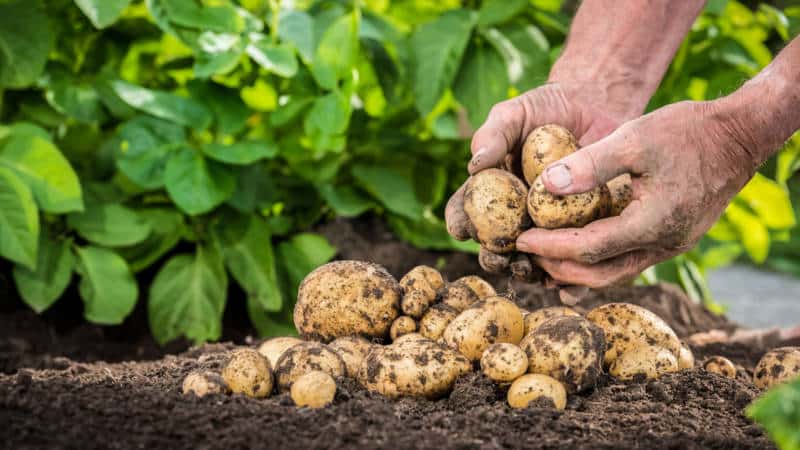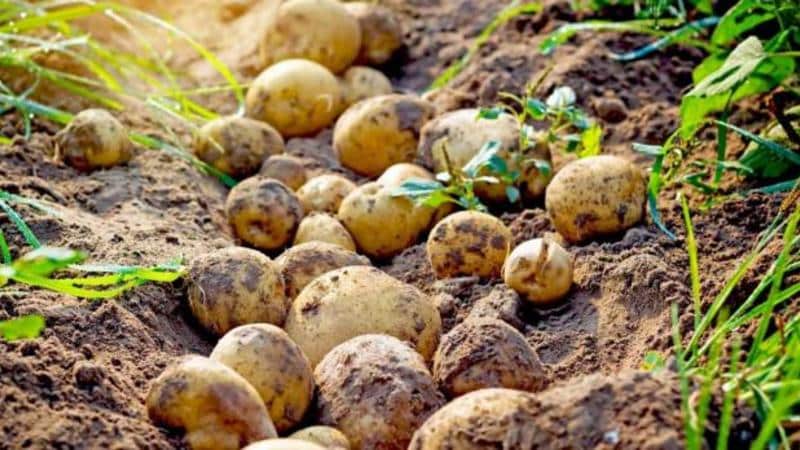How and when to dig potatoes for storage
Almost not a single dish of Russian cuisine is complete without potatoes, so growing them is a priority for many summer residents. However, not everyone is satisfied with the resulting harvest. In addition to the nuances of agricultural technology, the final result is affected by incorrectly chosen harvest dates. Some gardeners lack patience and dig up potatoes too early; others, on the contrary, keep it in the ground. In order not to guess and not rely on chance in this matter, you need to know the signs of potato maturity and follow simple harvesting rules.
When to dig potatoes for storage

Potatoes are dug up for food consumption much earlier than for storage. Young tubers are often eaten with the skin on. However, thin skin negatively affects the keeping quality of the vegetable. To survive long-term storage, the tubers must acquire a protective crust.
Another reason why potatoes should not be dug up too early is that it is at the end of the growing season that the yield reaches its limit.
“Over-seasoned” potatoes lose their taste because nutrients are used to form new sprouts, and the vegetative cycle begins anew. Such tubers are not stored for a long time.
Dates for different varieties and regions
According to the length of the growing season, 6 varieties of potato varieties are distinguished:
- very early — 35-50 days;
- early — 50-65;
- mid-early - 65-80;
- mid-season — 80-95;
- mid-late — 95-110;
- late - 110-120.
Depending on the variety, the vegetable ripens 1.5-4 months after planting.
Reference! Early varieties have less shelf life than late ones. They are planted for consumption immediately after digging.
The time for digging potatoes also depends on the climatic conditions of the region. The general rule is that this should be done before the first autumn frosts and the prolonged rainy season:
- in the Urals, Siberia and the North of Russia - in mid-August;
- in the North-West region - at the end of August;
- in the Far East - in early September;
- in the Volga region, Krasnodar region and Kaliningrad - in mid-September.
In drought conditions, potatoes ripen faster, so in the North Caucasus (Dagestan, North Ossetia) and Crimea the harvest is already in July.
How to determine if potato tubers are ripe

It is not always convenient to focus on varieties and conventional terms for different regions, since the ripeness of a vegetable depends on many factors. Therefore, a number of external signs are used to determine maturity.
Two main signs of potato maturity:
- withered and dried tops;
- dense and thick skin of tubers.
When focusing on the condition of the tops, remember that they turn yellow and wither due to a number of external reasons. For example, it negatively affects the condition of stems and leaves:
- excess nitrogen;
- heavy rainfall in summer and dry autumn;
- late blight.
Some agronomists advise not to wait until the potato tops dry out completely, but to dig up the crop when the above-ground part has withered by 70-80%. This will avoid dehydration of the tubers due to the evaporation of moisture through the stems and leaves.
The most reliable way to know when to harvest potatoes is to dig up a test bush.The tubers should not be too small, in sufficient quantities, the peel should not crack or peel when rubbed.
Important! The readiness of the potatoes for digging is also indicated by cracks on the ridges of the earth near the bushes. Growing tubers push the soil around them, and potholes appear on the surface.
What affects the ripening time of potato tubers?
Weather conditions, the quality of soil and seed material - all this affects the length of the growing season.
Belonging to the variety

Very early potato varieties are the first to ripen: Ariel, Impala, Uladar. In favorable climatic conditions, up to 3 harvests are harvested, since the full growing season of these varieties takes less than 2 months.
Early varieties (Alena, Zhukovsky early, Udacha) are good for regions with short summers. They are resistant to various diseases and pests: late blight, scab, nematode etc.
Mid-early varieties (Lily, Red Scarlett, Rowan) are stored for storage 2-2.5 months after planting. Tubers are more starchy because they have time to accumulate sugar from the soil.
Mid-season and mid-late varieties (Lugovskoy, Lorch, Sante) requires ripening from 80 to 110 days, i.e. all summer.
Finally, late potatoes (Atlant, Zarnitsa, Picasso) has the longest growing season (120 days or more). It is the lightest and most nutritious. These varieties are suitable for growing in the south.
Soil composition and applied fertilizers
Fertile soil increases the ripening period of potatoes. The fact is that the tubers try to absorb all the nutrients from the soil, so they grow larger and starchier, but take longer to ripen.
In light and poor soil, the vegetable takes up mineral compounds much faster, and accordingly, ripens earlier.
Reference. Clay soils increase the growing season, because such soil retains water.
Fertilizing has a positive effect on the quality of the crop, but delays its harvest. Be especially careful with mineral nitrogen fertilizers, which mainly feed the green mass, slowing down the ripening of tubers.
Frequency of watering and rain
The hotter and drier the weather, the earlier the crop is harvested, because when the soil warms up to +25°C, the tubers stop growing. Being without moisture for a long time, they become dehydrated, become lethargic and wrinkled, and lose their taste.
If the summer is rainy and cold, the potatoes ripen more slowly. In addition, cold dew causes the development of fungal diseases.
Important! Tubers are dug up in dry and warm weather. Those collected in the rain quickly rot.
Region
The agroclimatic conditions of most of Russia can hardly be called favorable. The term “risky farming zone” is more suitable for them: return frosts are possible after planting seed material, often during a cold and rainy summer period.
The long-term cultivation of potatoes is also not conducive to how quickly the thermometer drops in the fall. Therefore, in the Northern, Northwestern regions, the Urals and Siberia, the harvest is completed no later than mid-September.
The hot and arid climate (for example, in the North Caucasus) also forces local agronomists to grow early varieties in order to have time to harvest them before the tubers are completely dehydrated.
The most favorable conditions for agricultural purposes are the Volga region and the Central Black Earth region, where late varieties are grown and they manage to obtain several harvests of very early ones.
Is it possible to dig potatoes if the tops are still green?
The state of the green mass is only an indirect sign of the maturity of the tubers. However, if the tops remain fleshy and green, this means that they are still receiving enough nutrients, and perhaps the tubers are not getting enough of them. In order not to guess, it is better to dig up one or several bushes and check the thickness and strength of the potato peel.
Attention! As a rule, potatoes intended for storage begin to be harvested no earlier than about 70-80% of the tops have withered.
How to properly dig potatoes from the garden

To keep the harvest longer, potatoes must be dug up carefully, avoiding damage (cuts, punctures, dents). The correct equipment and careful handling of tubers will help with this.
Potato harvesting methods
There are 2 options for harvesting potatoes:
- manual;
- mechanical.
The use of special attachments is justified for large planting areas. But in order for the walk-behind tractor wheels to move freely across the field, the beds themselves must be level, and there must be sufficient distance between the ridges. A certain skill is also required in order to adjust the potato digger to the desired depth.
What and how to dig potatoes
When harvesting use:
- A shovel. The traditional tool is bad because it often leaves cuts on the tubers.
- Pitchfork. They require more physical effort, but damage vegetables less than a shovel.
- Various modifications of walk-behind tractors. Significantly simplify the process through mechanization.
Do I need to mow the tops before harvesting?
The question of whether it is necessary to pre-mow potato tops is controversial and largely depends on the harvesting method:
- If the potatoes are dug up with pitchforks or shovels, and the planted area itself is small, the procedure is not necessary. When harvesting manually, it is convenient to grab the bush with your free hand and pull out the tubers along with the roots.
- If a walk-behind tractor is used, clearing the field of tops makes the task easier: it is easier to move around, select tubers from the soil, etc.
In any case, the tops should be burned and not used for compost heaps, especially if the potatoes have been grown in the same area for several years. Pathogens of infectious diseases overwinter in plant debris.
Potatoes are dug up 7-10 days after mowing the tops. During this time, the tubers will absorb the minerals intended for the green mass.

Preparing potatoes for storage
Before removing potatoes from the garden for storage, they must be dried. If the soil is sandy and the weather is dry and warm, do this right in the field, scattering the potatoes in a thin, even layer. When air or soil humidity is high, the crop is placed under an artificial canopy.
Important! With prolonged exposure to sunlight, green spots form on the tubers - accumulations of the toxic substance solanine. Therefore, it is better to choose a shaded area.
The potatoes are then sorted by size and degree of damage. Cut, broken, affected specimens are disposed of or, after appropriate treatment, given to livestock feed. Typically, summer residents divide the remaining tubers into potatoes for storage and further use as food and seed material.
Conclusion
The timing of potato harvesting is influenced by many factors, so exact and universal dates cannot be given. When to dig potatoes, each gardener determines for himself, focusing on the characteristics of the planted varieties, the agroclimatic conditions of the region, the weather and the agricultural technology used (watering, fertilizing, etc.).